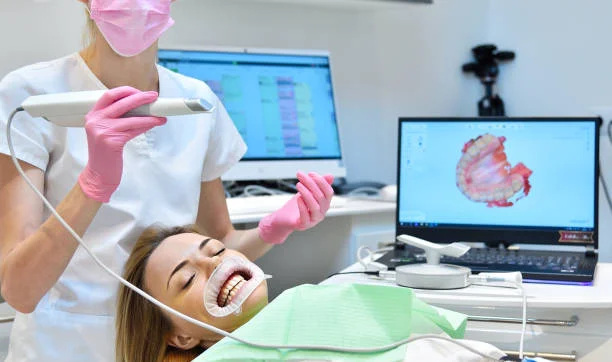In today’s image-conscious world, a beautiful smile is more than just a confidence booster—it’s a symbol of health, self-care, and personal expression. As dental technology evolves, one innovation stands out for its transformative power in restorative dentistry: Digital Smile Design (DSD). This cutting-edge approach is revolutionizing how dentists plan, execute, and perfect smile makeovers, blending science and aesthetics into a seamless process.
Still curious? Here’s another read we think you’ll love.
What Is Digital Smile Design?
Digital Smile Design is a modern dental technology that uses digital imaging, computer-aided design (CAD), and facial analysis to create highly personalized smile transformations. Unlike traditional restorative dentistry methods, which often rely on manual impressions and guesswork, DSD allows dentists to visualize and simulate the final outcome before any physical treatment begins.
Using photographs, videos, 3D scans, and advanced software, a dentist can analyze a patient’s facial structure, lip movement, and teeth alignment to design a smile that harmonizes with their unique features. It’s not just about fixing teeth—it’s about crafting a smile that fits naturally and enhances the person’s overall appearance.
The Power of Visualization
One of the most exciting aspects of digital smile design is its ability to show patients a preview of their new smile. This digital mock-up acts like a visual blueprint that takes the uncertainty out of cosmetic and restorative procedures. Patients can see, tweak, and approve their future smiles before any work is done, increasing their confidence and satisfaction with the treatment.
This level of visual planning also improves communication between patients and dental teams. It allows for clear discussions about expectations, concerns, and desired outcomes—something that was harder to achieve with traditional methods.
Precision in Restorative Dentistry
Restorative dentistry focuses on repairing and replacing damaged or missing teeth to restore function and aesthetics. Digital smile design takes this a step further by introducing unparalleled precision. Whether it’s crowns, bridges, veneers, implants, or a full-mouth reconstruction, DSD ensures every element of the treatment is planned to exact specifications.
Using intraoral scanners and digital impressions, dentists can create restorations that fit better, last longer, and look more natural. The result is a smile that not only functions well but also reflects the patient’s personality and lifestyle. For complex cases, DSD even allows for interdisciplinary collaboration between orthodontists, prosthodontists, and oral surgeons to coordinate care with exceptional accuracy.
Aligning with Modern Smile Trends
In the world of aesthetics, smile trends continue to evolve. Patients are no longer just seeking the “Hollywood smile” with ultra-white, perfectly aligned teeth. Today’s trends lean toward natural-looking results that match individual features, facial symmetry, and personality traits.
DSD supports this shift by enabling dentists to customize every detail—from tooth shape and size to color and alignment. Whether the trend calls for a youthful smile with rounded edges or a mature, sophisticated look with defined contours, digital smile design makes it possible to tailor the results precisely to patient preferences.
Moreover, smile trends now emphasize wellness and long-term oral health. Patients want treatments that are not just cosmetic but also sustainable. DSD helps achieve this by promoting minimally invasive procedures and preserving as much of the natural tooth structure as possible.
Enhanced Workflow and Patient Experience
Another benefit of digital smile design in restorative dentistry is the improved workflow. Traditional processes often involve multiple appointments, physical molds, and adjustments. With DSD, many of these steps are streamlined or eliminated. The digital workflow allows for faster turnaround times, fewer errors, and greater consistency in results.
For the patient, this means shorter treatment durations, less discomfort, and a more engaging experience. It also encourages active participation in the design process, which leads to higher satisfaction and trust in the dental provider.
Building a Smile that Lasts
A successful smile restoration is not just about immediate appearance—it’s about longevity and durability. With DSD, dentists can simulate the effects of time, wear, and bite pressure on the restorations. This predictive modeling helps in choosing the right materials and design elements to ensure that the new smile remains beautiful and functional for years to come.
Additionally, because of the accuracy provided by digital impressions and computer-guided planning, patients experience fewer complications or adjustments down the line. It’s an investment in both aesthetics and health.
Digital smile design is more than a technological trend—it’s a philosophy that places the patient at the center of a personalized, data-driven, and beauty-conscious treatment journey. In restorative dentistry, it represents a paradigm shift where precision meets beauty, resulting in smiles that are not only visually stunning but also functionally superior.
As smile trends continue to emphasize individuality, natural aesthetics, and health-conscious choices, DSD is poised to remain at the forefront of modern dentistry. For anyone considering a restorative dental procedure, choosing a provider who embraces digital smile design could be the first step toward a future of confident, lasting smiles.
Catch up on the latest updates anytime from 2A Magazine.







